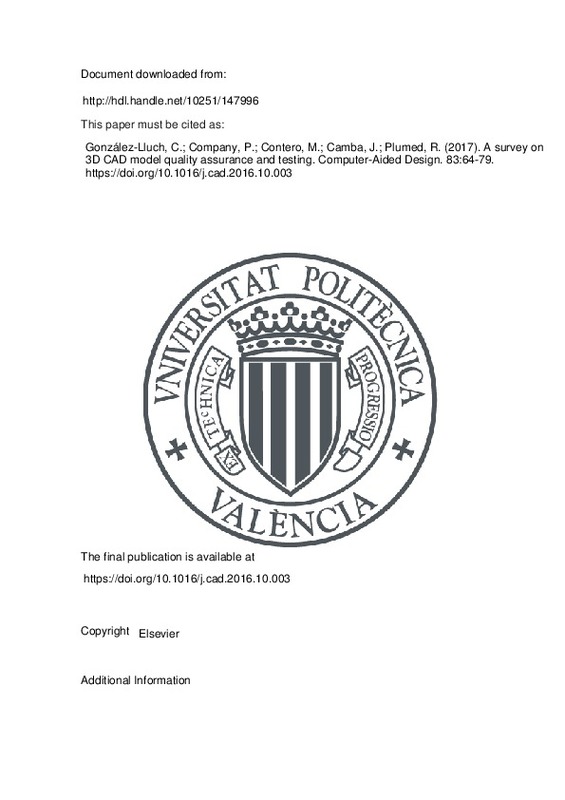JavaScript is disabled for your browser. Some features of this site may not work without it.
Buscar en RiuNet
Listar
Mi cuenta
Estadísticas
Ayuda RiuNet
Admin. UPV
A survey on 3D CAD model quality assurance and testing
Mostrar el registro sencillo del ítem
Ficheros en el ítem
| dc.contributor.author | González-Lluch, C.
|
es_ES |
| dc.contributor.author | Company, P.
|
es_ES |
| dc.contributor.author | Contero, Manuel
|
es_ES |
| dc.contributor.author | Camba, J.D.
|
es_ES |
| dc.contributor.author | Plumed, R.
|
es_ES |
| dc.date.accessioned | 2020-07-15T03:32:01Z | |
| dc.date.available | 2020-07-15T03:32:01Z | |
| dc.date.issued | 2017-02 | es_ES |
| dc.identifier.issn | 0010-4485 | es_ES |
| dc.identifier.uri | http://hdl.handle.net/10251/147996 | |
| dc.description.abstract | [EN] A new taxonomy of issues related to CAD model quality is presented, which distinguishes between explicit and procedural models. For each type of model, morphologic, syntactic, and semantic errors are characterized. The taxonomy was validated successfully when used to classify quality testing tools, which are aimed at detecting and repairing data errors that may affect the simplification, interoperability, and reusability of CAD models. The study shows that low semantic level errors that hamper simplification are reasonably covered in explicit representations, although many CAD quality testers are still unaffordable for Small and Medium Enterprises, both in terms of cost and training time. Interoperability has been reasonably solved by standards like STEP AP 203 and AP214, but model reusability is not feasible in explicit representations. Procedural representations are promising, as interactive modeling editors automatically prevent most morphologic errors derived from unsuitable modeling strategies. Interoperability problems between procedural representations are expected to decrease dramatically with STEP AP242. Higher semantic aspects of quality such as assurance of design intent, however, are hardly supported by current CAD quality testers. (C) 2016 Elsevier Ltd. All rights reserved. | es_ES |
| dc.description.sponsorship | This work was supported by the Spanish Ministry of Economy and Competitiveness and the European Regional Development Fund, through the ANNOTA project (Ref. TIN2013-46036-C3-1-R). | es_ES |
| dc.language | Inglés | es_ES |
| dc.publisher | Elsevier | es_ES |
| dc.relation.ispartof | Computer-Aided Design | es_ES |
| dc.rights | Reconocimiento - No comercial - Sin obra derivada (by-nc-nd) | es_ES |
| dc.subject | Quality assurance | es_ES |
| dc.subject | CAD model quality testing | es_ES |
| dc.subject.classification | EXPRESION GRAFICA EN LA INGENIERIA | es_ES |
| dc.title | A survey on 3D CAD model quality assurance and testing | es_ES |
| dc.type | Artículo | es_ES |
| dc.identifier.doi | 10.1016/j.cad.2016.10.003 | es_ES |
| dc.relation.projectID | info:eu-repo/grantAgreement/MINECO//TIN2013-46036-C3-1-R/ES/LA APLICACION DE LAS ANOTACIONES 3D EN EL CONTEXTO INDUSTRIAL DE LA EMPRESA BASADA EN MODELOS (MODEL BASED ENTERPRISE) Y LA FORMACION TECNICA/ | es_ES |
| dc.rights.accessRights | Abierto | es_ES |
| dc.contributor.affiliation | Universitat Politècnica de València. Departamento de Ingeniería Gráfica - Departament d'Enginyeria Gràfica | es_ES |
| dc.description.bibliographicCitation | González-Lluch, C.; Company, P.; Contero, M.; Camba, J.; Plumed, R. (2017). A survey on 3D CAD model quality assurance and testing. Computer-Aided Design. 83:64-79. https://doi.org/10.1016/j.cad.2016.10.003 | es_ES |
| dc.description.accrualMethod | S | es_ES |
| dc.relation.publisherversion | https://doi.org/10.1016/j.cad.2016.10.003 | es_ES |
| dc.description.upvformatpinicio | 64 | es_ES |
| dc.description.upvformatpfin | 79 | es_ES |
| dc.type.version | info:eu-repo/semantics/publishedVersion | es_ES |
| dc.description.volume | 83 | es_ES |
| dc.relation.pasarela | S\355252 | es_ES |
| dc.contributor.funder | European Regional Development Fund | es_ES |
| dc.contributor.funder | Ministerio de Economía y Competitividad | es_ES |







![[Cerrado]](/themes/UPV/images/candado.png)

